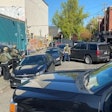Serving on a gang task force can be tough duty. Just ask Det. Ricky Smith of the Hempstead Village (N.Y.) Police Department. The more than 10 years that Smith has investigated and gathered intelligence on gangs in his suburban Long Island jurisdiction has been a bumpy ride. He’s had to convince other local officers that gangs were indeed a problem outside of the big cities. He’s had to fight against neighboring community leaders who believed that admitting they had gangs gave their towns a black eye. And he’s had to deal with vengeful gang members who have threatened himself, his partner, and their families.
Despite all that, Smith says he’s enjoyed the work. It’s been the challenge of his career. And he has gained a reputation as being one of America’s leading gang experts.
Bringing the Agency on Board
Smith started working gangs out of necessity. In 1995, he and his partner Det. Joe Serrano started to see the formation of some local gangs in his Village. They decided to take a closer look.
Focusing much of their time on gathering information, Smith and Serrano started a database that included the gang members’ names, nicknames, tattoos, pictures, arrests, where they hung out, and any other pertinent intelligence. The database now contains information on more than 1,200 gang members.
Early on in their investigations, it became clear to the detectives that these gangs were committing many of the major crimes in the Village, including assaults, robberies, and homicides.
Unfortunately, not everyone in the police department saw the gang threat the same way as Smith and Serrano did. While the younger cops seemed to take an interest, the older ones would say, “They are not gang members; they are just assholes. They are all just wannabes.” Smith fought back and told them it’s the wannabes that become gang members.
Smith and Serrano were fortunate to have the administration of the department on their side. His chief, James Russo, and the Village’s mayor supported their work. They also became big supporters of the task force and sent the detectives for ongoing gang training, something that would later prove invaluable.
“I think after some older members started to see the in-service training that Joe and I were giving, they began to accept that they didn’t know that much about gangs and maybe it was time to start realizing gangs are here and that they are dangerous and to start looking at things a little differently than they were,” Smith says.
For the first two years, the task force dealt with only local gangs. Then in 1996, Hempstead officers began to see evidence that MS-13 and the Bloods were moving into town.
“We were lucky enough to have had the training, so when we started to see an influx of MS-13 and Bloods, we at least knew what we were looking at,” says Smith.
Making Connections
Hempstead Village is a very small town covering only 3.5 square miles. But it is located in the center of Nassau County, so one of the first things that Smith and Serrano discovered about local gangs was that their criminal activities crossed into other jurisdictions. That meant their anti-gang activities would have to involve officers from the Nassau County Police and other nearby agencies.
[PAGEBREAK]
Unfortunately, gangs were not a subject that other local departments wanted to discuss. “Most of the departments didn’t want to admit there was a gang problem, and didn’t want us to tell them that we even saw a gang problem in their community because their thing was gangs make communities look bad, and they didn’t want the recognition of being a troubled community,” says Smith.
Still, despite the reluctance of other departments to admit it, Smith started seeing more and more evidence of gangs, including MS-13, Bloods, Latin Kings, Crips, Salvadorians with Pride, and even the Hells Angels.
Eventually, the other local agencies had to admit that gangs had come to suburban Long Island.
“We pushed for a gang task force to start and made connections with the DEA,” says Smith. In addition to the DEA, the task force included personnel from the New York State Police, the Nassau County Police, the Nassau County Sheriff’s Office, the Port Washington Police Department, the Freeport Police Department, and HUD. In 2003, the DEA pulled out and the FBI became the new lead federal agency.
Death Threats
Today, the task force is credited with years of solid investigations and gang interdiction. It’s sent really bad people to prison, provided evidence to deport gang leaders back to Central America, and prevented some local youths from joining gangs. The task force is a success.
But it wasn’t easy, and the years have taken a personal toll on Smith, who has even been the target of death threats from gang members.
The first came in 2000 when Smith received information through informants that an MS-13 member was planning a hit on he and Serrano. The information was confirmed by police officers from another local department through their informants. And the threat was taken very seriously.
Smith and Serrano were brought into headquarters and told to keep their guns on them at all times, to take home their radios, and to have CAPER alarms installed in their homes. In addition, the Nassau County Police were instructed to do intensive patrol of the two officers’ homes.
The threats also affected Smith’s family. He painfully recalls what it was like to tell his wife and his children that he and they were wearing bull’s eyes. With a young son in grammar school and a daughter in junior high, Smith also had to go to his children’s schools and tell the officials what was happening.
“My son thought it was cool, my daughter had a tougher time. We had to be stricter with them. We had to make sure we knew where they were at all times. It made their lives uncomfortable,” Smith says.
After awhile, things began to get back to normal. Then in 2002, the task force was doing some major investigations in the village, and through various informants they were told hits were being put out on task force members. Chillingly, they were told that several members of the task force had already been followed home, and the gang members knew where they lived and what types of cars they drove.
“One night, as I pulled out of work, I observed a car with four people inside parked in a driveway across the street,” Smith says. “As I pulled by, I recognized two of the people in the front street as MS gang members that I knew. They had been watching our office. So I went up to the corner and made a quick U turn. They shot up north. I followed them and ended up losing them.
“But since I knew who they were, we proceeded to intensify our enforcement of gangs. We let them know that we knew what was going on and pretty much told them if someone in the task force gets hit, their lives would not be worth living. We eventually locked up two people, and deported them, and after that the threat pretty much went away.”
[PAGEBREAK]
At least it went away for two years. Then in 2004, another MS-13 gang member leader was seen on numerous occasions taking photos of members of the task force. The gang member was trying to intimidate the task force.
But his plan backfired. Task force members did some research on him, found out that he had an outstanding immigration warrant for illegal entry, and they placed him under arrest for the immigration warrant.
For the next year, while waiting for his hearing, the gang member was confined in a New Jersey jail. During that time, his cell mate was an informant that worked for a department in that state. The MS-13 gang member told the informant that he was going to put a hit on Smith and Serrano and that he was trying to bring in two gang members from California to do the job.
After they received the information, law enforcement officials tried to put a tape on their informant, but the MS-13 member got suspicious and would not talk to him.
An Uphill Battle
In a perfect world, it would be easy to prosecute and convict gang members who threaten cops. In a logical world, it would even be easy to just deport gang members who are illegally in the United States.
Smith will tell you that this is not a perfect world. He would add that the justice system doesn’t adhere to any form of logic or common sense.
Smith was once at a gang seminar in the South, when he was ordered to return immediately to testify at the immigration hearing of the gang member who had issued the latest death threat. He told the authorities he was out of town, but the judge demanded his return by the next morning.
After driving all night to get back to New Jersey Smith gave his testimony. Then the judge announced that the defense did not have enough time to prepare his case, so she was going to postpone it.
“She said, ‘I will postpone it, but I have some questions that I want to ask you.’ At that time the judge asked me about 15 or 20 questions, which were pertinent to the case, and all it did was give the defense more information to ask me when he was ready to cross examine me,” Smith says.
Three weeks later he was ordered back to court when the MS-13 gang member’s attorney said he was not going to fight deportation for his client.
That should have been the end of the story. However, the judge asked the defendant’s lawyer, “Why are you doing that? I was going to find in your favor.” The defendant’s lawyer then explained that his client wanted to be deported because he knew that he would possibly face federal charges if he stayed on American soil.
But even then it was not over for Smith. The gang member who wanted Smith dead took a parting shot as he was on his way out of the courtroom. “He was being led out by two court officers, and he looked right at me and said, ‘I’ll see you soon.’”
Det. Smith says the task force now constantly looks for information on gang members from Virginia and California who come to the Island. “We still have to look over our shoulder and identify people and see what they are here for and know what is going on because we don’t know if [the gang leader who threatened our lives] ever got in contact with the people he said he was, but we did know he had contacts with major players in MS-13 in California.”
Taking the Good with the Bad
Despite the death threats and the frustration, Smith says he gets a lot of satisfaction from his job, has a lot of good memories, and knows that he has helped some people.
For example, there was an informant who Smith developed over the years that he helped get out of the gang life.
Smith met the informant when he arrested her on a charge of having gang members beat up her husband. But he felt there was more to the story. He listened to her and started feeling sorry for her and had a gut feeling that she wasn’t really the bad person in the relationship.
So Smith and his partner talked to her and she agreed to assist them with information on her gang. They were able to work numerous cases together, and she helped with solving many cases, including several homicides. She has since started a new life and is living with her parents, going to college, and raising her daughter.
[PAGEBREAK]
“She stays in touch with me, we still talk maybe twice a month,” Smith says. “She keeps telling me she owes everything to me because I straightened out her life, but I tell her that she is the one who changed her life.”
Unfortunately, Smith tells many other stories that didn’t end happily. “Seeing some of the young kids that are 14, 15, 16 getting killed because of stupid gang violence just gets to me. It’s amazing; you can talk to some kids that young and they think it fun and their life is exciting. They don’t realize what they are getting into until it is too late.”
Smith has also seen changes in the gangs. He says over the years they have gotten more sophisticated. For example, cell phones have given the gangs better communication.
“It makes it more dangerous for us cops,” Smith says. “They can let each member know what they are doing and to get together quickly. Next thing you know there are 15 or 20 gang members on a corner causing problems.”
Constant Vigil
After all these years going after gangs, has the task force made a difference? As with most things, the answer depends on which angle you look at.
“The numbers go down after you lock them up,” says Smith. “Then after a couple months, you see some new younger kids joining, and numbers go up. It is a continuing job for us no matter what. Get rid of some, next thing you know get some new ones.”
So why does a cop stay part of a task force, especially when, as in the case of Smith, it affects his family and his wife, who has learned to constantly look over her shoulder?
He says the answer is simple. “I worry about my family, but you also have to live your life. It’s part of being a police officer. It’s what we do.”















